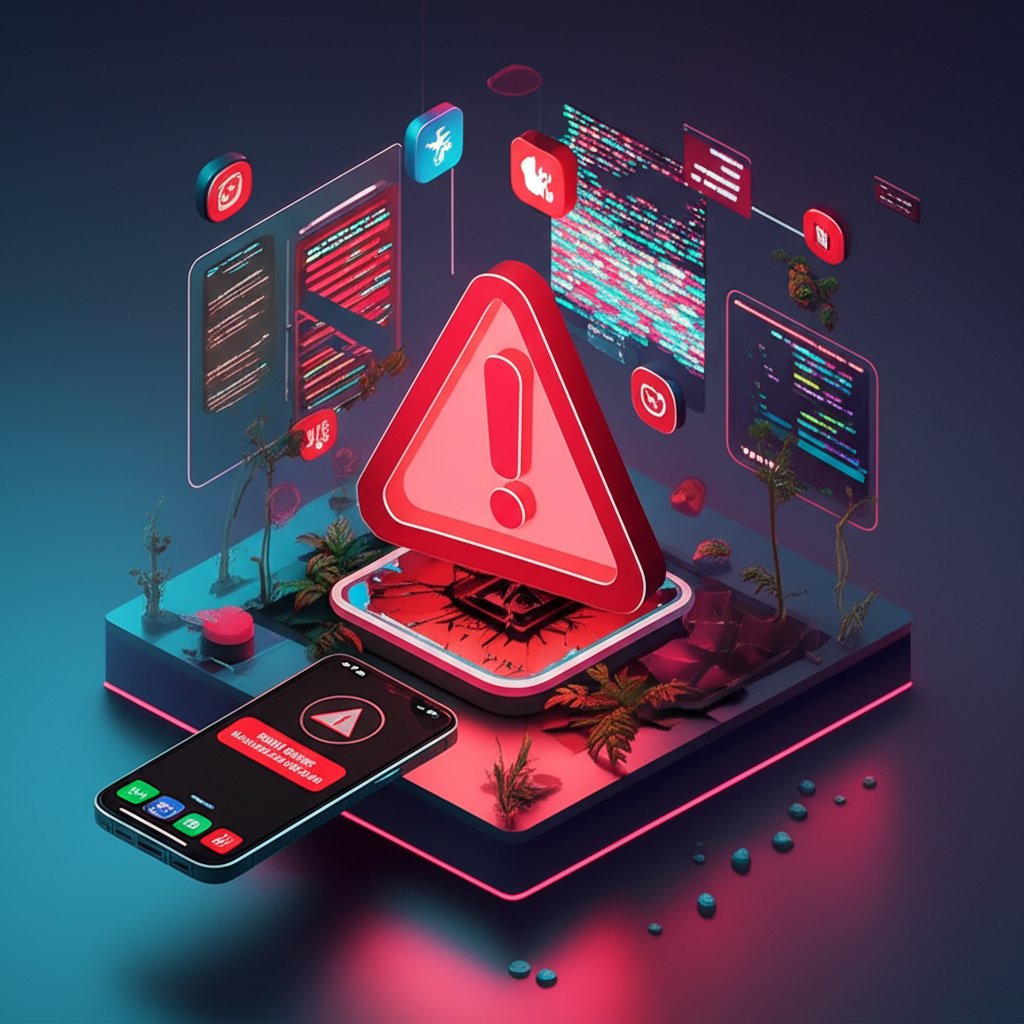You unlock your screen, ready to check an email or scroll through social media, and there it is—a new icon on your home screen. You pause, confused, because you know you didn’t install it. The moment an unfamiliar app appeared on my phone is unsettling, sparking questions about whether your device is secure, who put it there, and what you should do next.
Most of the time, the explanation is surprisingly mundane. But sometimes, it’s a red flag you can’t afford to ignore. This guide will walk you through every likely cause, from the harmless to the hazardous, and give you a clear plan to investigate, remove the app, and secure your phone for good.
At a Glance: Your Key Takeaways
- Identify the Source First: The most common culprits are your mobile carrier (like Verizon or T-Mobile), your phone’s manufacturer (like Samsung), or your Google account restoring old apps.
- Benign vs. Malicious: An app from your carrier is usually bloatware—annoying but safe. An app from an unknown source that asks for invasive permissions is a serious security risk.
- Safe Mode is Your Best Diagnostic Tool: Booting into Safe Mode temporarily disables all third-party apps. If the problem stops, a recently installed app is likely the cause.
- Permissions Are Everything: Some apps trick you into giving them permission to install other apps. Regularly auditing “Install unknown apps” is critical.
- Immediate Action Required: Never ignore a mysterious app. At best it’s wasting space; at worst it’s malware designed to steal your data.
The Usual Suspects: Why Most Mysterious Apps Aren’t Malicious
Before assuming the worst, let’s explore the most common and generally harmless reasons why a new app might show up. These account for the vast majority of cases and are usually tied to the services that manage your phone.
Your Carrier or Manufacturer Pushed an Update
Mobile carriers and phone manufacturers often have their own “app manager” services that run in the background. Their purpose is to install or recommend promotional apps, updates, or tools they believe are helpful. You often agree to this in the terms and conditions during the initial phone setup.
- Carrier Bloatware: Services like
Verizon App Manager,T-Mobile AppSelector, or AT&T’sAppSelectare notorious for this. They can silently install apps overnight, often related to games, partner services, or carrier-specific tools. - Manufacturer Apps: Samsung’s Galaxy Store might automatically install or update apps it considers part of its ecosystem. Similarly, a system service like
Mobile Services Manager(often found on various Android devices) can be used to push app installations as part of a system update.
Case Snippet: A user noticed a new game, “Bingo Blitz,” on their phone. They never installed it. After checking their app list, they found a system app called “AppSelector” had been active right before the game appeared. This was their carrier, T-Mobile, pushing a promoted application.
Your Google Account Restored It
Did you recently reset your phone or sign into a new Android device? When you set up a phone with your Google account, it automatically tries to restore your previously installed apps from a cloud backup.
Sometimes, this process includes apps you forgot you ever had, or even apps you installed briefly years ago. If an app appeared on my phone right after a factory reset, this is almost always the reason. The restore process can take hours or even days, so an app might pop up long after the initial setup seems complete.
Another App Store Is Auto-Updating
While Google Play is the main app store, your phone might have others. Samsung devices have the Galaxy Store, and some users install third-party stores like the Amazon Appstore.
If you have auto-updates enabled in any of these stores, they can add an app’s icon back to your home screen after an update. You might have removed the icon, but the app was never uninstalled. The update simply makes it visible again. This is a common source of confusion, but it’s different from your phone downloading new apps all by itself. For a complete overview of how to manage these automatic downloads, our guide can help you Stop apps downloading automatically.
When to Be Concerned: Red Flags of a Malicious Install

While most cases are benign, sometimes an unexpected app is a sign of something more sinister. Malware, particularly adware and spyware, often gets onto a device by hiding within another app or tricking the user into granting dangerous permissions.
An Existing App Has Rogue Permissions
The most common way malware installs other apps is by abusing a powerful permission: “Install unknown apps.” You might have granted this permission to a seemingly harmless app—like a file manager or a browser—to install a legitimate app from outside the Play Store. However, if that app was malicious, it now has a permanent key to install anything it wants without asking you again.
This is a classic Trojan horse attack. The app you installed works as expected, but in the background, it’s a gateway for adware, spyware, or other unwanted software.
You Sideloaded an App from an Unsafe Source
Downloading an app’s APK file from a random website instead of the Google Play Store is called “sideloading.” While it’s a useful feature for advanced users, it’s also the easiest way to get infected.
Hackers often take popular apps, inject them with malicious code, and upload them to third-party download sites. When you install it, you get the app you wanted plus a hidden payload that can install other apps, steal your data, or display intrusive ads.
Your Google Account Has Been Compromised
This is rare but serious. If a hacker gains access to your Google account, they can remotely install any app from the Google Play Store website onto any device linked to that account. They don’t need physical access to your phone.
If you see an unfamiliar app and notice other strange activity—like password reset emails you didn’t request or sign-in alerts from unknown locations—you should assume your account is compromised and act immediately.
Your Step-by-Step Investigation Playbook

When an unfamiliar app has appeared on your phone, don’t just delete it and move on. Follow these steps to understand where it came from and ensure your device is secure.
Step 1: Gather Intelligence on the App
First, don’t open the app. Press and hold its icon and tap the “i” (or “App info”) button. This takes you to its system settings page. Look for two key pieces of information:
- App Name and Version: Note the exact name.
- Source of Installation: Scroll to the bottom and tap “App details.” This will show you where it was installed from (e.g., “Installed from Google Play Store,” “Installed from Galaxy Store,” or sometimes it might be blank or list a package installer).
If it says it was installed from the Play Store, you can tap that to read reviews and see if other users report similar strange behavior. A quick Google search of the app’s name can also reveal if it’s known bloatware or malware.
Step 2: Check Your App Store History
Go to the Google Play Store, tap your profile icon, and select “Manage apps & device.” Go to the “Manage” tab, tap “Installed,” and sort by “Recently updated.” See if the mysterious app appears here. Do the same for any other app stores you have, like the Samsung Galaxy Store. This helps confirm if it came from a legitimate (though perhaps unprompted) source.
Step 3: Audit “Install Unknown Apps” Permissions
This is one of the most critical security checks you can perform.
- Go to Settings > Apps > Special app access.
- Tap on Install unknown apps.
- You’ll see a list of apps on your phone. Go through each one. The only apps that should ever have this permission are trusted app stores like Google Play or perhaps your primary web browser if you knowingly sideload apps.
- If you see a random game, utility, or anything else with this permission set to “Allowed,” turn it off immediately. This was likely the gateway.
| App Type | Should it have this permission? | Action |
| :— | :— | :— |
| Google Chrome | Maybe, if you’re an advanced user. | Disable unless you know you need it. |
| Google Play Store | Yes, this is normal. | Leave it enabled. |
| WhatsApp/Signal | No, never. | Disable immediately. |
| A random game | No, absolutely not. | Disable and consider uninstalling the game. |
| File Manager | Maybe, for advanced users. | Disable unless you use it to install APKs. |
Step 4: Use Safe Mode to Isolate the Problem
Safe Mode reboots your phone with all third-party apps disabled. It’s the ultimate test to see if an app you installed is causing the problem.
- Press and hold the power button until the power menu appears.
- Press and hold the “Power off” or “Restart” option.
- A “Reboot to Safe Mode” prompt will appear. Tap “OK.”
Your phone will restart with “Safe Mode” written on the screen. Now, use your phone for a while. If no new apps appear and other strange behavior (like pop-up ads) stops, it confirms that a third-party app is the culprit. Reboot your phone normally to exit Safe Mode, then start uninstalling your most recently installed apps one by one until the problem is solved.
Step 5: Run a Comprehensive Malware Scan
If you suspect malware, a dedicated security app is your best bet. Install a reputable antivirus app from the Google Play Store—options from Bitdefender, Malwarebytes, Norton, or Avast are industry standards. Run a full system scan. These tools are specifically designed to detect and remove malicious apps and files that you might miss on your own.
Quick Answers to Common Questions
Here are fast, direct answers to the most frequent concerns when a strange app appears on your phone.
Q: An app appeared on my phone that I can’t uninstall. What now?
A: If the “Uninstall” button is grayed out, it’s likely a system app or carrier bloatware. You can’t remove it, but you can “Disable” it from the App Info screen. Disabling an app prevents it from running, using data, or appearing in your app drawer. It’s the next best thing to uninstalling. If it’s a malicious app masquerading as a system app, a factory reset might be necessary after backing up your data.
Q: Is this a sign my phone has a virus?
A: It can be, but it’s not the most likely explanation. First, rule out carrier bloatware, manufacturer suggestions, and Google account restores. A “virus” (more accurately, malware) is a strong possibility if the app has a generic name (like “Cleaner” or “Booster”), asks for many permissions, and appeared after you downloaded something from a shady website.
Q: Can my mobile carrier legally install apps without my permission?
A: Yes, in most cases. When you activate service or set up your device, the terms and conditions you agree to often grant them permission to manage software on your device, which includes installing and updating their own or partner apps. It’s an unpopular practice, but it’s common across the industry.
Q: How can I prevent this from happening again?
A: Be proactive. Regularly review which apps have “Install unknown apps” permission. Avoid downloading apps from outside the Google Play Store unless you are certain the source is safe. Finally, go through your phone’s app list and disable any carrier-specific “App Manager” or “AppSelector” services you find.
Your Final Checklist for a Clean Device
Don’t let a mysterious app leave you feeling powerless. The appearance of an unexpected app is a signal to perform a quick security audit. Go through your device and check off these final action items:
- Investigate and Uninstall: Identify the unknown app through its “App Info” page. If it’s not essential, uninstall or disable it.
- Lock Down Permissions: Go to
Settings > Apps > Special app access > Install unknown appsand revoke permission for everything except the Google Play Store. - Secure Your Google Account: Change your Google password and enable Two-Factor Authentication (2FA) to prevent remote, unauthorized app installations.
- Run a Malware Scan: Use a trusted antivirus app to scan your phone for any hidden threats you may have missed.
By treating a strange app not as a panic moment but as a routine check-up, you can quickly resolve the issue and keep your digital life secure and under your control.
- Why an App Appeared on My Phone Unexpectedly - November 22, 2025
- How to Stop Unwanted Apps from Automatically Downloading on Android - November 21, 2025
- Why Are Android Games Installing Themselves on Your Phone? - November 20, 2025










